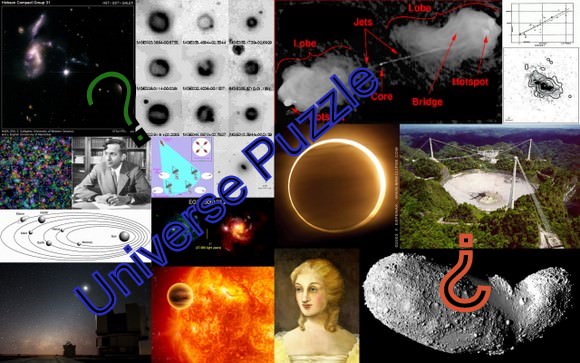As with last week’s Universe Puzzle, something that cannot be answered by five minutes spent googling, a puzzle that requires you to cudgel your brains a bit, and do some lateral thinking. This is a puzzle on a “Universal” topic – astronomy and astronomers; space, satellites, missions, and astronauts; planets, moons, telescopes, and so on.
As this week’s puzzle may be a bit harder than most, I’ll be adding a HINT tomorrow, if it looks like no one is even close to being on the right track.
UPDATE: Answer has been posted below.
What do the following objects have in common?
NGC 6822, NGC 598, NGC 221, NGC 224, and NGC 5457.
Together with the Large Magellanic Cloud (LMC) and Small Magellanic Cloud (SMC), these are the seven galaxies (“nebulae”) with the most reliable distances, used by Edwin Hubble to establish the distance-redshift relationship, in his landmark 1929 paper. Today we call this the Hubble relationship.
“The data are given in table 1. The first seven distances are the most reliable, depending, except for M 32 the companion of M 31, upon extensive investigations of many stars involved.”
Hubble, Edwin, “A Relation between Distance and Radial Velocity among Extra-Galactic Nebulae” (1929) Proceedings of the National Academy of Sciences of the United States of America, Volume 15, Issue 3, pp. 168-173
Note that not all are in the Local Group, and they are not the five brightest galaxies in Table 1. Figure 1 from that paper is reproduced in the Universe Puzzle graphic; it’s at the top right.
Well done Matthew Burns and iantresman!
Check back next week for another Universe Puzzle!


Not an answer (I don’t have a clue, and I don’t have the time to go dig stuff up), but a suggestion: wouldn’t it be worth it, if this is going to be a regular feature, to file it under something other than “astronomy”?
The are all nearby spiral galaxies that were photographed by Barnard. The were observed by Shapley for Cepheids, and I think they were example of galaxies instead of extragalactic nebula. They were (as a wider guess) all mentioned in the Great Debate between Heber and Shapley!
THEY ARE ALL FORMED AS A RESULT OF “BIRKELAND CURRENTS”!!1!1!! 😛
None of them have been to my house.
I think these were the “five brightest ‘diffuse nebula'” that Hubble provided the spectral characteristics, luminosities and dimensions for in the paper he puplished in 1925
It seems all above mentioned galaxies are part of the Local Group of galaxies in which the Milky Way also resides.
And by the way, I registered my account just to answer this question so I hope it better be worth it =)
Well,
They are in the 200 brighest galaxies list, according to the Third Reference Catalogue of Bright Galaxies
“THEY ARE ALL FORMED AS A RESULT OF “BIRKELAND CURRENTS”!!1!1!!”
I’m not a EU advocate so don’t peg me as one.
The forum rules include “Be nice”. Doesn’t that apply to everyone and not just the folks with the “personal theories”?
Nothing personal IVAN3MAN_AT_LARGE. I’ve noticed the sarcastic comments on several posts but just decided this time to say something.
Wow! I’m impressed!!
More than one person has come close (but no one has, yet, got it exactly right), which is *much* better than I’d expected.
Well done.
(Answer tomorrow, as usual)
———————————————————–
On another note, I second JackyP’s comment: please, everyone, be nice.
Ah. The also all had very negligible redshifts, but they were observed by Hubble as negative redshifts (blueshifts) I.e moving towards us!!